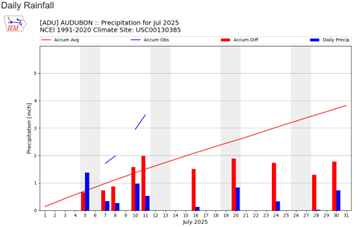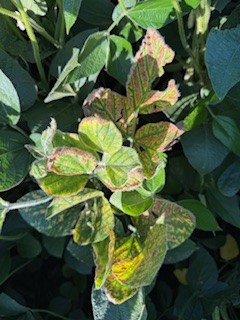Corn & Soybean Disease Watch Out
posted
by Makayla Bueltel on 8/6/2025
in
Weekly Newsletter
.png)
As we move into August, crop progress has been moving along quickly with above normal precipitation and warmer temperatures. July brought significant rainfall across the area, especially here in Audubon County, where we’ve already accumulated 5.49 inches with more on the way. For comparison, we were sitting at just 2.67 inches at this time last year. Corn is progressing rapidly, with most fields now sitting between the R4 (dough) and R5 (dent) stage. This is a critical period for kernel development, where consistent moisture and disease management are key to protecting yield. Soybeans are either around the R5 (beginning seed) and some early maturities have reached R6 (full seed) growth stage. Over the coming weeks, I’ll be actively monitoring fields for progression of diseases, sudden death, gall midge, white mold, and conducting kernel counts.

Latent Period
This growing season has brought on more than its fair share of challenges. With above-average rainfall and frequent heavy dew, disease pressure in corn and soybeans has been especially high. Southern Rust and Tar Spot have been particularly aggressive, and many growers have wisely turned to fungicide applications to help manage the threat. But now, as fungicide season wraps up, many are asking the same question: “Why am I still seeing disease in my fields?” It’s a valid concern—but the answer often lies in a concept that doesn’t always get enough attention: the latent period. For more information on the latent period reference the BASF video here.
The latent period is the window of time between when a plant is first infected by a disease and when visible symptoms appear. Depending on the disease and environmental conditions, this period can last anywhere from several days to a few weeks. That means your crop could have been infected well before you applied fungicide—even if it looked completely healthy at the time of application. Once that latent period ends, symptoms emerge, and it can seem like the fungicide didn’t work-however the fungicide absolutely did work. While we can’t undo infections that occurred during the latent period, fungicides are crucial in preventing new infections but also slowing down the disease progression.
Tar Spot:
One of the challenges with managing Tar Spot in corn is its long latent period, which can range from 14 to 21 days. During this time, the fungus (Phyllachora maydis) is actively infecting the plant, but you won’t see any visible symptoms yet—such as the characteristic black, raised stromata on the leaves. This delay between infection and symptom development can give the false impression that fungicides aren't working, when in reality, the infection likely occurred well before the fungicide application. Tar Spot thrives under cooler temperatures, high humidity, and prolonged leaf wetness—conditions that have been all too common this season. Recognizing these infection windows and understanding the latent period is essential for timing fungicide applications and managing expectations around disease control.
Southern Rust:
This year, Southern Rust has become very prevalent in corn across the region. Warm, humid conditions combined with frequent rainfall and extended leaf wetness have created an ideal environment for rapid disease development and spread. Southern Rust, caused by Puccinia polysora, has a short latent period of just 6 to 10 days. This means plants can be infected and show no visible symptoms for up to a week or more. When symptoms do appear—typically as orange to tan pustules clustered on the upper leaf surface—the disease may already be well established in the field. If you notice Southern Rust symptoms shortly after a fungicide application, it’s likely the infection occurred prior to spraying, during that asymptomatic window. The fungicide is still valuable for slowing further spread and protecting healthy leaf tissue, but it won't reverse symptoms from earlier infections.
Northern Corn Leaf Blight:
Northern Corn Leaf Blight is a foliar disease that can significantly reduce yield potential if not properly managed. The disease typically begins as long, gray-green to tan elliptical lesions on the lower leaves. Under favorable conditions, these lesions can expand quickly and merge, reducing the plant’s photosynthetic capacity during the critical grain fill stages. The latent period for Northern Corn Leaf Blight ranges from 7 to 14 days. This can vary depending on corn hybrid. It thrives in temperatures (65–80°F), high humidity, and in fields with corn-on-corn rotations or high crop residue.
Sudden Death
Sudden Death Syndrome (SDS) is one of the most damaging diseases in soybeans, capable of causing significant yield loss when conditions are favorable, cool and wet. SDS is caused by the soilborne fungus Fusarium virguliforme, which is able to overwinter in residue and soil that infects roots early in the season —even though symptoms don’t typically appear until the reproductive stages (R3–R6). Foliar symptoms show up once the toxins relocate from the infected root and crown tissue to the foliage.

As you can see here this soybean plant has developed yellow spots on the leaves between the veins which is a strong indication of SDS. Eventually those yellow spots will turn brown as the tissue dies which we can see is starting to take place here along the edges of the leaves. SDS is a difficult disease, but it’s manageable with a layered approach. Start with resistant genetics, pair them with a strong seed treatment, manage SCN populations, and avoid risky planting conditions.